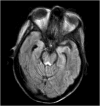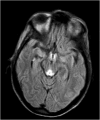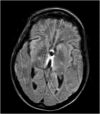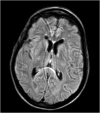Association between malignancy and non-alcoholic Wernicke's encephalopathy: a case report and literature review
- PMID: 31386087
- PMCID: PMC6668278
- DOI: 10.1093/nop/npv036
Association between malignancy and non-alcoholic Wernicke's encephalopathy: a case report and literature review
Abstract
Background: Wernicke's encephalopathy is a serious medical condition associated with high morbidity and mortality caused by deficiency of thiamine. This disease is classically associated with alcoholism, but is underappreciated in the nonalcoholic population. There is growing acknowledgement of the development of Wernicke's encephalopathy in patients with malignancies.
Methods: We conducted a literature review in PubMed for cases of Wernicke's encephalopathy occurring in patients with malignancy. We also present the case of a 47-year-old woman with recurrent laryngeal cancer and multiple hospital admissions for malnutrition. Neurological examination was notable for pendular nystagmus, severe gait ataxia, confusion, and poor memory consolidation. MRI of the brain was significant for T2-weighted fluid-attenuated inversion recovery hyperintensities in periaqueductal regions, medial thalami, and the tectal plate, typical for Wernicke's encephalopathy. She was treated with thiamine repletion, and had marked improvement in her mental status and some improvement in her vision problems and ataxia, although some nystagmus and significant short-term memory impairment persisted.
Results: The literature review yielded dozens of case reports of Wernicke's encephalopathy in patients with malignancy, dominated by cases of patients with malignancies of the gastrointestinal system, followed by those with hematologic malignancies.
Conclusions: Malignancy is an important risk factor for the development of Wernicke's encephalopathy. This diagnosis is underappreciated and difficult for the clinician to discern from multifactorial delirium. Clinicians should be aware to treat at-risk patients with thiamine immediately, especially if multiple risk factors are present.
Keywords: Wernicke's; cancer; encephalopathy; malignancy; non-alcoholic.
Figures




Similar articles
-
A Case of Wernicke's Encephalopathy After Sleeve Gastrectomy.Endocr Metab Immune Disord Drug Targets. 2023;23(12):1548-1551. doi: 10.2174/1871530323666230508152340. Endocr Metab Immune Disord Drug Targets. 2023. PMID: 37157214
-
Wernicke's Encephalopathy: Typical Disease with an Atypical Clinicoradiological Manifestation.J Neurosci Rural Pract. 2020 Jul;11(3):487-488. doi: 10.1055/s-0040-1713334. Epub 2020 Jun 12. J Neurosci Rural Pract. 2020. PMID: 32753819 Free PMC article.
-
Nonalcoholic Wernicke's Encephalopathy: A Retrospective Study from a Tertiary Care Center in Northern India.J Neurosci Rural Pract. 2017 Jul-Sep;8(3):401-406. doi: 10.4103/jnrp.jnrp_14_17. J Neurosci Rural Pract. 2017. PMID: 28694620 Free PMC article.
-
Malnutrition-induced Wernicke's encephalopathy following a water-only fasting diet.Nutr Clin Pract. 2015 Feb;30(1):92-9. doi: 10.1177/0884533614561793. Epub 2014 Dec 18. Nutr Clin Pract. 2015. PMID: 25524882 Review.
-
[Thiamine in patients with alcohol use disorder and Wernicke's encephalopathy].Ned Tijdschr Geneeskd. 2017;161:D931. Ned Tijdschr Geneeskd. 2017. PMID: 28224875 Review. Dutch.
Cited by
-
Interplay Between Thiamine and p53/p21 Axes Affects Antiproliferative Action of Cisplatin in Lung Adenocarcinoma Cells by Changing Metabolism of 2-Oxoglutarate/Glutamate.Front Genet. 2021 Apr 1;12:658446. doi: 10.3389/fgene.2021.658446. eCollection 2021. Front Genet. 2021. PMID: 33868388 Free PMC article.
-
Wernicke's Encephalopathy: Similar and Different Aspects of the Three Cases.Noro Psikiyatr Ars. 2019 Aug 16;57(2):165-168. doi: 10.29399/npa.22854. eCollection 2020 Jun. Noro Psikiyatr Ars. 2019. PMID: 32550785 Free PMC article.
-
Fulfilling the purpose and scope of Neuro-Oncology Practice.Neurooncol Pract. 2016 Sep;3(3):137-138. doi: 10.1093/nop/npw018. Epub 2016 Aug 16. Neurooncol Pract. 2016. PMID: 31386092 Free PMC article. No abstract available.
References
-
- Sechi G, Serra A. Wernicke's encephalopathy: new clinical settings and recent advances in diagnosis and management. Lancet Neurol. 2007;6(5):442–455. - PubMed
-
- Thomson AD, Ryle PR, Shaw GK. Ethanol, thiamine, and brain damage. Alcohol Alcohol. 1983;18(1):27–43.
-
- Lindboe CF, Loberg EM. Wernicke's encephalopathy in non-alcoholics. An autopsy study. J Neurol Sci. 1989;90(2):125. - PubMed
-
- Newman ME, Adityanjee, Sobolewski E, Jampala VC. Wernicke-Korsakoff amnestic syndrome secondary to malnutrition in a patient with schizoaffective disorder. Neuropsychiatry Neuropsychol Behav Neurol. 1998;11(4):241–244. - PubMed
LinkOut - more resources
Full Text Sources
Other Literature Sources

